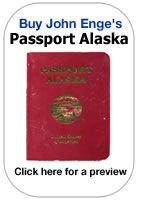
WANTED: better fisheries mousetrap engineers
January 15th, 2006
We hearken to more evolved fisheries lest we repeat the mistakes of history. That sounds good on paper, but special interests running U.S. fisheries law-making aren't so Utopian. Compare current U.S. law-making to this article from the U.K.
It's central theme is this quote: "In reality, the quota system often creates as many problems as it solves, and may even be counterproductive. Using modern vessels that have enormous capacity, crews routinely throw much of their catch back into the sea to comply with reduced quotas. While catching fish over quota is not illegal, landing it would lead to fines and criminal charges."
The other cautionary note from this fishery is that even with quotas, fishermen find themselves fishing in the worst weather of the year, and with foreign nationals that have little experience, but are cheap to hire. The fish processing plants in Alaska have already gone the recent immigrant route, with Dutch Harbor elementary school students speaking 17 different languages. They make up 50% of the student body.
With consolidation in the fishing sector, through MSA machinations, following hard on the heels of consolidation in the processing sector, we can probably expect to see more foreign nationals in the U.S. fleet as well. If the lawmakers are going to give the bulk of the fishing opportunity to large corporations, they should allow for a class of commercial fishing called "handlining" like in the Philippines. Coastal villages in the U.S. are going the way of other countries hardscrabble fishing villages. Two classes of fishermen. One with all the technology and capacity they can handle(generally non-resident), and one that is basically trying to catch some fish to put on the table and maybe sell to get some firewood too.
This business model below looked interesting, and a sign that lots of other folks are worried that doing nothing at the grass roots level is a recipe for disaster. Maybe it's a starter kit for the new Regional Seafood Development Associations.
Mission: The ................... works to strengthen and connect businesses and community members in ........................ who share a commitment to creating an economy that preserves community character and vitality, promotes social justice, and protects ecological health and diversity.
Members are locally owned businesses (and fishermen) working together to:
1. Support the growth and development of each other and community-based business in general.
2. Encourage local purchasing by consumers and businesses(that means no more black-balling fishermen for trying to form RSDAs)
3. Network and share best practices.
4. Advocate public policies that strengthen independent local businesses and (fishermen), promote economic equity, and protect the environment(public members and others watch for creek robbing and by-catch with web cams, etc.)
Programs:
1. The Flavor Campaign: helps consumers "think local first" for their shopping needs. Through the .................. Flavor guidebook and in-store label we encourage your support and appreciation of our local (fishermen) and artisan producers of specialty foods.
2. The Food Connection: fosters collaboration between (fishermen) chefs, retailers, and processors committed to expanding and strengthening regional and sustainable (fishing) through annual conferences(ugh, more conferences) and print directory of local food products.
3. Industry Workshops and Roundtables: quarterly meetings focus on (fishing) business planning, best practices, marketing and regulatory issues.
4. Community Education: We have a growing library of economic sustainability books, periodicals, and DVDs for rental. Teachers and community groups are welcome to contact us and we will be glad to suggest possible speakers tailored to your interests.
5. Regional business infrastructure needs: We are working with other local groups to ensure our (fishermen) and food entrepreneurs have access to local facilities to process their products.
See more at John Enge's Blog
See John Enge's Previous Posts On AlaskaReport Here
John lived in Alaska for 50 years and has run commercial boats and processing plants. John also served as a loan officer and economist for a "fishing bank" and served as the only Fisheries Infrastructure Development Specialist the state has had. He has owned a marine design and fabrication business and created the best-selling "Passport Alaska." All photos on his blog are his own, unless so noted.
Contact John Enge

